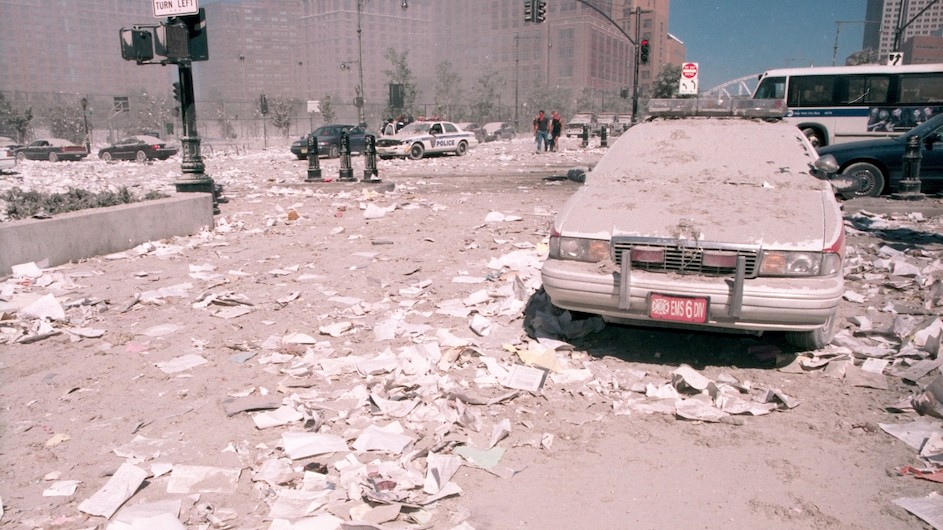Columbia’s 9/11 Oral History Project Allows Us to ‘Think About It Differently’
Today, the September 11, 2001 Oral History Project contains over 900 recorded hours with more than 600 people.

Two commercial jets fly into the Twin Towers. The Pentagon is attacked by another airplane. Yet another jet crashed into a field in Pennsylvania. These are indelible memories from September 11, 2001, but these visuals cannot tell the full story of 9/11. How do you document a catastrophe?
A day or two after September 11, 2001, Kenneth Jackson, professor of history and a New York City historian, asked Mary Marshall Clark, director of the Center for Oral History Research, to talk to his history class about the process of oral history under conditions of trauma. After that class and at Jackson’s suggestion, Clark decided to create an oral history project.
Following a conversation with then-University Provost, Jonathan Cole, Clark reached out to Peter Bearman, professor of sociology and current director of INCITE, to help design the project.
With Clark’s experience as an oral historian and Bearman’s sociology expertise, the September 11, 2001, Oral History Project began to take shape.
Columbia Remembers September 11
"For me, it was a breakthrough in the field of oral history," Clark said, reflecting on the marriage of these two disciplines, “because it was a moment through engaging with Peter, we were engaging with sociology, with the social sciences. And that has really changed the way we have worked since.”
To better understand the long-term impact of the day, Bearman created a longitudinal component to the project, where interviewers would continue to speak to their subjects for a year and half.
Bearman and Clark also knew that the oral histories needed to capture voices from a broad swath of New York City. “It’s not just the EMT. It’s not just the first responders. It’s not just the people directly involved," Bearman said. "It’s those who are seemingly distal, but their experiences, thoughts, sadnesses, meanings make them close to the whole story.”
To do this, the project sought out people whose stories weren’t represented in the news media at the time, such as immigrants from the Middle East, transnationals from Mexico, and members of New York City’s Chinatown community.
Two decades have passed since the terrorist attacks, and the 9/11 Oral History Project contains over 900 recorded hours (23 hours on video) with more than 600 people.
“This distance in time will allow people, if they go back to this archive to think about it differently. They have different problems that they’re concerned with that can speak to them in ways that we hadn’t anticipated,” Bearman said.
However, Clark cautions not to put too much weight on the anniversary "out of respect for those who lost loved ones." She said that the "most painful" time for survivors, is "the day of the anniversary.”
So far, 687 hours with 351 individuals are now open and available to the public through our Columbia Libraries archive. Below, are four excerpts from the project.
Excerpts From the September 11, 2001 Oral History Project
We did a lot of wandering around, walking around in an apocalyptic world. There were crushed cars, cars on fire, gutted cars that had been on fire and burnt themselves out, or had been put out. Finally ─ I guess it must have been about 11:00 at night ─ we made it over to the West Side Highway. We came out about four or five blocks above where the towers had been. I think that was the first time it hit me that they were really, completely gone. There was really nothing but a big, big, big pile of nothing.
By the time I arrived to Atlantic Avenue where I park my car, I saw the first tower ─ the second tower fell first. And I was shocked. I thought this building would never fall, and I was so mad and upset, because I used to love this building. I used to eat in the Windows Around the World. I used to bank over there at CitiBank. And any visitor coming from overseas, the first thing I take them to is the World Trade Center, actually to impress them with the World Trade Center.
Most of the people that started out with me actually were able to leave quicker, because there were two or three times when we had to change the staircases. I mean, these staircases don’t run from top to bottom. They are broken for structural reasons.
I was walking very, very slow by now because I could barely walk. In the concourse level I was going so slow that two or three times people offered to carry me and I said, “No, no, maybe somebody else needs help.” You know, the water was this much, up to my ankles, and it was slimy and slippery. My shoes were new and they were slipping.
And then I look over my shoulder and now Lower Manhattan is covered in apocalyptic smoke and flames. The second tower had just gone down, that was the rumble we felt. And I just looked back and saw this scene of horror to me: smoke, strange lights from flame, utterly impossibly beautiful blue sky ultimately above it all. It reminded me of a propaganda poster that was produced in World War I, which showed the Statue of Liberty as the victim of an attack, and a U-boat surfacing in New York Harbor, and it says, "Don't Let It Happen Here." And my thought was, "Holy shit, like it's happening here."